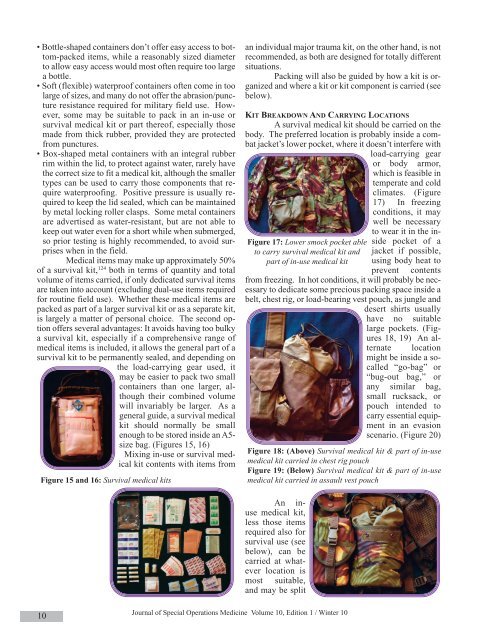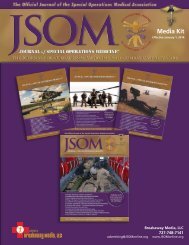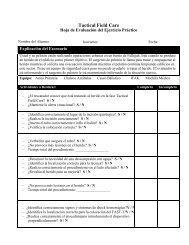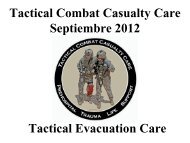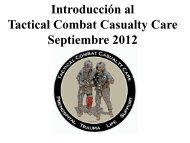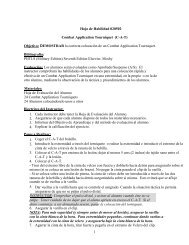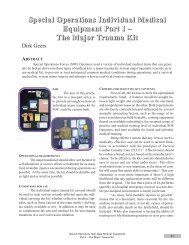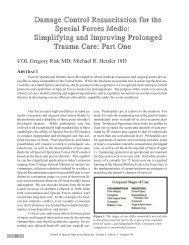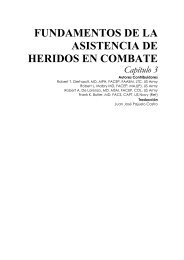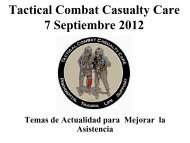Geers D. Special Operations Individual Medical Equipment Part 2
Geers D. Special Operations Individual Medical Equipment Part 2
Geers D. Special Operations Individual Medical Equipment Part 2
You also want an ePaper? Increase the reach of your titles
YUMPU automatically turns print PDFs into web optimized ePapers that Google loves.
• Bottle-shaped containers don’t offer easy access to bottom-packed<br />
items, while a reasonably sized diameter<br />
to allow easy access would most often require too large<br />
a bottle.<br />
• Soft (flexible) waterproof containers often come in too<br />
large of sizes, and many do not offer the abrasion/puncture<br />
resistance required for military field use. However,<br />
some may be suitable to pack in an in-use or<br />
survival medical kit or part thereof, especially those<br />
made from thick rubber, provided they are protected<br />
from punctures.<br />
• Box-shaped metal containers with an integral rubber<br />
rim within the lid, to protect against water, rarely have<br />
the correct size to fit a medical kit, although the smaller<br />
types can be used to carry those components that require<br />
waterproofing. Positive pressure is usually required<br />
to keep the lid sealed, which can be maintained<br />
by metal locking roller clasps. Some metal containers<br />
are advertised as water-resistant, but are not able to<br />
keep out water even for a short while when submerged,<br />
so prior testing is highly recommended, to avoid surprises<br />
when in the field.<br />
<strong>Medical</strong> items may make up approximately 50%<br />
of a survival kit, 124 both in terms of quantity and total<br />
volume of items carried, if only dedicated survival items<br />
are taken into account (excluding dual-use items required<br />
for routine field use). Whether these medical items are<br />
packed as part of a larger survival kit or as a separate kit,<br />
is largely a matter of personal choice. The second option<br />
offers several advantages: It avoids having too bulky<br />
a survival kit, especially if a comprehensive range of<br />
medical items is included, it allows the general part of a<br />
survival kit to be permanently sealed, and depending on<br />
the load-carrying gear used, it<br />
may be easier to pack two small<br />
containers than one larger, although<br />
their combined volume<br />
will invariably be larger. As a<br />
general guide, a survival medical<br />
kit should normally be small<br />
enough to be stored inside an A5-<br />
size bag. (Figures 15, 16)<br />
Mixing in-use or survival medical<br />
kit contents with items from<br />
Figure 15 and 16: Survival medical kits<br />
an individual major trauma kit, on the other hand, is not<br />
recommended, as both are designed for totally different<br />
situations.<br />
Packing will also be guided by how a kit is organized<br />
and where a kit or kit component is carried (see<br />
below).<br />
KIT BREAKDOWN AND CARRYING LOCATIONS<br />
A survival medical kit should be carried on the<br />
body. The preferred location is probably inside a combat<br />
jacket’s lower pocket, where it doesn’t interfere with<br />
load-carrying gear<br />
or body armor,<br />
which is feasible in<br />
temperate and cold<br />
climates. (Figure<br />
17) In freezing<br />
conditions, it may<br />
well be necessary<br />
Figure 17: Lower smock pocket able<br />
to carry survival medical kit and<br />
part of in-use medical kit<br />
to wear it in the inside<br />
pocket of a<br />
jacket if possible,<br />
using body heat to<br />
prevent contents<br />
from freezing. In hot conditions, it will probably be necessary<br />
to dedicate some precious packing space inside a<br />
belt, chest rig, or load-bearing vest pouch, as jungle and<br />
desert shirts usually<br />
have no suitable<br />
large pockets. (Figures<br />
18, 19) An alternate<br />
location<br />
might be inside a socalled<br />
“go-bag” or<br />
“bug-out bag,” or<br />
any similar bag,<br />
small rucksack, or<br />
pouch intended to<br />
carry essential equipment<br />
in an evasion<br />
scenario. (Figure 20)<br />
Figure 18: (Above) Survival medical kit & part of in-use<br />
medical kit carried in chest rig pouch<br />
Figure 19: (Below) Survival medical kit & part of in-use<br />
medical kit carried in assault vest pouch<br />
An inuse<br />
medical kit,<br />
less those items<br />
required also for<br />
survival use (see<br />
below), can be<br />
carried at whatever<br />
location is<br />
most suitable,<br />
and may be split<br />
10<br />
Journal of <strong>Special</strong> <strong>Operations</strong> Medicine Volume 10, Edition 1 / Winter 10


